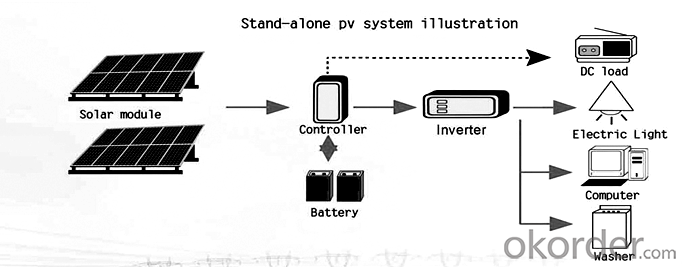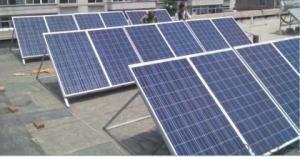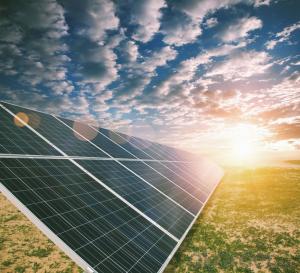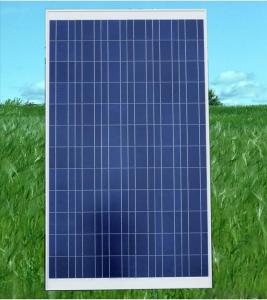Solar Panel 310W Polycrystalline Silicon
- Loading Port:
- Guangzhou
- Payment Terms:
- TT OR LC
- Min Order Qty:
- 200000 watt
- Supply Capability:
- 20000000 watt/month
OKorder Service Pledge
OKorder Financial Service
You Might Also Like
Introduction
This installation Manual contains essential information for the electrical and mechanical installation that your must know before installing CUSTOMER PV modules. This also contains safety information you need to be familiar with .All the information described in this manual are the intellectual property of CNBM and based on the technologies and experiences that have been acquired and accumulated in the long history of CUSTOMER. This document does not constitute a warranty, expressed or implied.
CUSTOMER does not assume responsibility and expressly disclaims liability for loss, damage, or expense arising out of in anyway connected with installation, operation, use or maintenance of the PV modules. No responsibility is assumed by CUSTOMER for any infringement of patents or other rights of third parties that may result from use of PV module.
CUSTOMER reserves the right to make changes to the product, specifications or installation manual without prior notice.
Work Principle

Components

Data sheet
Maximum power | 310W |
Cell type(mm) | Polycrystalline solar cell 156*156 |
Number of cell(pcs) | 72(6*12) |
Manufacture site | China |
Open-circuit voltage(voc) | 45V |
Maximum power voltage(vmp) | 37V |
Short-circuit current(isc) | 8.8A |
Optimum operating current(imp) | 8.38A |
Power tolerance | 0~+5W |
Module efficiency | 16% |
Dimensions(mm) | 1956*992*40 |
Weight | 27 kg |
Backsheet | Silver |
Frame Colar | White |
Frame | Anodized Aluminum Alloy |
- Q:does it mean that it can get that much in a day? Or like, in an hour?
- watt is a measurement of energy watt=3.4 BTU BTU(British thermal unit )=amount of energy to raise pound water degree f. us gallon water = 8.33 lbs can gallon water = 0 lbs depending if 0vac then a solar panel can light a 00 watt bulb or 6 5watt high efficiency bulbs
- Q:In terms of efficiency and cost, what is the best solar panel. I am limited in the number of panels I can put up (probably 6-8) so they must be efficient, but cost is important also.What about these panels that can collect a wider range of light frequency?
- You have to decide which is more important to you, cost or efficiency. The most efficient solar panels that are commercially available cost more than twice as much per square foot than the cheapest ones. Ultimately, I believe that the cost per watt was actually better on the cheaper, least efficient panels, but then you need a lot of square footage in order to generate any substantial power. So it comes down to what you have more of, space or money. The new panels that collect a wider range of light are not currently available commercially, and when they are I am sure that they will be expensive. I have read the research but have not heard of anyone mass producing them yet.
- Q:Okay, I think I understand what I'm doing, but I want to set up some solar panels on the roof of my garage, the building that gets the most sun, and I want to make sure all my math is correct in determining number of megawatts per year. However, my knowledge of electrical terms in quite n00bish, to say the least.Here is what I think I should be doing.The solar cells come at .75 Watts average power.I will install 4 panels of 64 cells each, with a total of 256 cells.
- For comparison, 36 of these make a normal 2V x 50W panel. Note they are not tabbed. This means you have to find a way to connect them yourself. The tabs are probably spot welded on by the suppliers. A supplier below has kits of these with tabs, as needed to connect them together. These are not suitable for grid connect, because the higher voltage needed makes do it yourself panels a dangerous and litigious thing to have on your roof. Maybe you could buy a smaller pack from the link below to compare tabbed and untabbed and work out what to do. Your power calculation is a bit incorrect because the sun is only present some of the time. The 36 cell module would produce 50W when square on to the full sun. The sun may be out for around 2h a day in some places and times of the year. However it is the equivalent of 5h full sun, because of the changing angle throughout the day. Look this up on the internet for your region. Temperate zones may be a lot less. One pack in your link is 36x3 = 08 cells. Thus 50W per pack x 5h a day gives 750Wh per day and 274KWh/y. In reality it will always be less because of regions, weather, clouds, dust, inefficiencies, aging of cells.
- Q:Please tell me what they are made of and how the materials help the solar cell produce electricity. Im doing a science projects so i need help on knowing all this info. Its a debate, so i need correct information please.I will please need more information about the bad things about solar energy and solar panels. Please say what solar panels do to create pollution or do anything that is not friendly to the environment. If you want just give me a website. Thank you
- A okorder /, or resistance—vary when light is incident upon it) which, when exposed to light, can generate and support an electric current without being attached to any external voltage source, but do require an external load for power consumption.
- Q:It measured volts before I attached it, and after attaching the voltage regulator device, the voltage dropped down to 3 volts, even when just measuring the difference in the solar panels nodes themselves, suggesting that the entire panels voltage dropped and not just the voltage in the regulator. I tried testing it with a power supply of 7 V 0. A and it works fine, but I don't know why it won't work for the solar panel.
- you cannot treat the open circuit voltage of a solar panel like a voltage source (like a battery.) the load response of the panel doesn't behave that way. small panels and panels that are producing less than about .5A are very happy to have their output voltage pulled down to whatever they're connected to (typically zero.) I observed the same phenomenon when i connected a 2V 725mA panel to a 2V 325mA fan -- the open circuit voltage of 5V dropped to 3V when connected to the fan, and returned to 5V when disconnected. The easiest workaround is to use 2V of rechargable batteries in parallel with the panel so that the battery holds the 2V potential difference and the panel just supplies the current. any excess current charges the batteries, so you might consider whether or not you need some type of charge controller to prevent burning the batteries via overcharging. there are actually very few applications of solar panels connected directly to circuits that i have seen that have any kind of robust performance -- if they work at all, they eventually die/burn themselves out in a couple of months. the best robust designs always have a rechargable battery and charge controller somewhere in the power circuitry to buffer the load circuit from the panel. .
- Q:Can solar panels be used in areas with extreme temperatures?
- Yes, solar panels can be used in areas with extreme temperatures. While extreme heat can reduce the efficiency of solar panels, modern solar technologies are designed to withstand high temperatures. Similarly, solar panels can also operate in extremely cold temperatures, although their performance may be slightly affected. Overall, solar panels can still generate electricity effectively in areas with extreme temperatures.
- Q:Can solar panels be installed on camping sites?
- Yes, solar panels can be installed on camping sites. They provide a sustainable and renewable source of energy, allowing campers to power their equipment and devices while minimizing their environmental impact.
- Q:I am writing some mock legislation for a school club and I need to know some of the environmental effects of solar panels. Also, where can I find specific studies(like from colleges and/or universities) proving these benefits as well as benefits and reasons of going green.
- I'm okorder / I hope this gives you some insight and at least a start. Enjoy.
- Q:Can solar panels be installed on senior living facilities?
- Yes, solar panels can be installed on senior living facilities. Installing solar panels on senior living facilities can help reduce energy costs, promote sustainability, and provide clean and renewable energy for the facility. It can be a beneficial and cost-effective solution for senior living facilities to meet their energy needs while also contributing to a greener environment.
- Q:Can solar panels be installed on military bases or installations?
- Yes, solar panels can be installed on military bases or installations. In fact, many military bases worldwide have already implemented solar energy systems to reduce their dependence on fossil fuels, lower greenhouse gas emissions, and enhance energy security. These installations not only help save costs in the long run but also contribute to a more sustainable and resilient infrastructure for military operations.
1. Manufacturer Overview |
|
|---|---|
| Location | |
| Year Established | |
| Annual Output Value | |
| Main Markets | |
| Company Certifications | |
2. Manufacturer Certificates |
|
|---|---|
| a) Certification Name | |
| Range | |
| Reference | |
| Validity Period | |
3. Manufacturer Capability |
|
|---|---|
| a)Trade Capacity | |
| Nearest Port | |
| Export Percentage | |
| No.of Employees in Trade Department | |
| Language Spoken: | |
| b)Factory Information | |
| Factory Size: | |
| No. of Production Lines | |
| Contract Manufacturing | |
| Product Price Range | |
Send your message to us
Solar Panel 310W Polycrystalline Silicon
- Loading Port:
- Guangzhou
- Payment Terms:
- TT OR LC
- Min Order Qty:
- 200000 watt
- Supply Capability:
- 20000000 watt/month
OKorder Service Pledge
OKorder Financial Service
Similar products
New products
Hot products
Related keywords






























